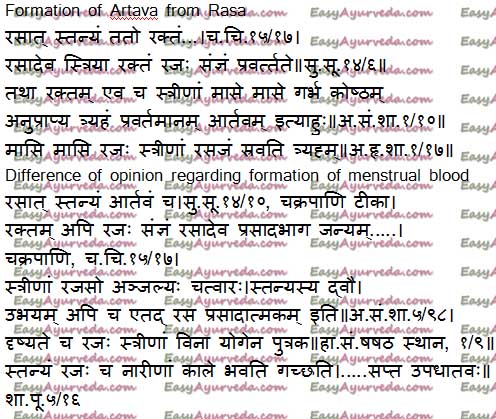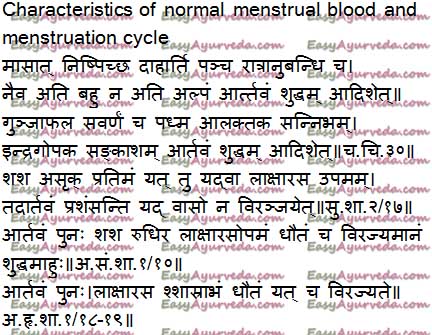Artava – Menstrual Blood Formation, Healthy Characteristic Features
By Dr Raghuram Y.S. MD (Ay) & Dr Manasa, B.A.M.S
Menstrual blood is an sub-tissue of rasa dhatu. Term artava or raja is also used to describe the ovum.
Related Reading – Upadhatu Of Rasa Dhatu – Stanya, Arthava: Sub Tissues Of Rasa
Table of Contents
Formation
Formation of menstrual blood from Rasa
Food we take gets digested in stomach and intestines. From digested food nutritional juices i.e ahara rasa is formed. This nutritional juices helps in formation of all tissues of the body in chronological order. First tissue formed from nutritional juices is rasa dhatu i.e. lymph or plasma tissue.
From Rasa dhatu, blood named raja is formed. Blood reaching uterus and getting expelled for three days in every month in a woman is called arthava. The menstrual blood is formed from the essence part of lymph or plasma i.e rasa.
Thus, food juices forms and nourishes lymph tissue. This lymph tissue takes part in the formation of blood tissue. Due to action of tissue fire of lymph tissue, part of nutrition becomes lymph tissue and nourishes local tissue, another part moves ahead to nourish blood tissue, a part of lymph tissue forms menstrual blood and breast milk as byproducts and kapha is formed as waste of this metabolic process. This menstrual blood goes to the uterus and gets eliminated during monthly periods of a woman for 3 days.
Read – Dhatu Mala: Tissue Waste Products: Ayurveda perspective
Sanskrit sloka

Difference of opinion
Difference of opinion regarding formation of raja or menstrual blood –
According to Charaka, Sushruta, Vriddha Vagbhata, Dalhana and Chakrapani – menstrual blood is formed from lymph i.e rasa
According to Vagbhata – blood which gets accumulated in uterus and then gets discharged is menstrual blood. Menstrual blood is derived from the essence portion of lymph.
Read – Immunity In Ayurveda: Concept, Diet, Herbs, Medicines, Exercise
When we analyze both these opinions, there would not be any controversy; in fact the concepts are identical. Blood immaterial of it being in tissue form or in form of menstrual blood is always formed from rasa dhatu. This implies that Charaka etc have explained the earlier stage of formation of raja while Vagbhata has explained the later stage.
Charaka etc have not given different names for the menstrual blood as raja and arthava. They just say that raja is formed from rasa. It needs to be understood that the raja is formed from rasa and is eliminated from the uterus during monthly periods in women.
Since it is formed from rasa which is soumya or cold in nature, the raja too will initially have the same soumya character according to Chakrapani.
Read – Menstrual Pain, Painful Periods – Natural Ayurvedic Herbal Home Remedies
Vagbhata explains the formation of menstrual blood in two stages for easy understanding –
The essence portion of byproduct of rasa is raja, i.e. raja is formed from rasa.
This Raja reaches and accumulates in uterus and gets eliminated for 3 days every month in women. The raja which gets expelled from the uterus or vagina during the monthly periods is called arthav.
Vagbhata might have named the same menstrual blood by two terms to make the physiology easily understandable. We can infer that the raja is formed from rasa but by the time it gets expelled out of the vagina during monthly periods there would be lot of changes in its form and consistency. To denote this he has used two terms, raja for initial formation of menstrual blood and artavam for the late stage transformed raja which gets eliminated during the periods. We need to remember that whether it is raja or arthavam, it is formed from rasa dhatu.
The arthav may be expelled after one month time, but it is a transformed form of raja and raja is a byproduct or upadhatu of rasa. Hence artav is an upadhatu of rasa dhatu.
Read – Rasa Panchaka – 5 Qualities Of Substance (Dravya)
Clarification by Chakrapani
Chakrapani, the commentator of Charaka clarifies that during the process of formation from rasa, the artava is soumya i.e. cold in nature due to the influence of rasa, while at the time of its excretion from uterus the artava assumes agneya character i.e. fiery character due to certain specific changes.
The alteration in artava is brought due to change in character caused by doshas. This happens just like the solid substances are changed into fumes due to the action of fire and also just like the sugarcane juice which usually vitiates kapha, after fermentation into wine which now vitiates all the three doshas.
The soumya artava explained by Chakrapani is the raja explained by Vagbhata. This is formed from rasa tissue. The agneya artava explained by Chakrapani is the artava which gets expelled from uterus during monthly periods as explained by Vagbhata.
According to Arunadatta – raja is formed from ahararasa i.e. food juices and not from rasa dhatu .
According to Sharngdhara and Bhavamishra – raja is byproduct i.e. upadhatu of rakta.
According to Harita, raja is formed without any obvious reason or effort
Sharangdhara has said that raja is the byproduct of blood. Its manifestation i.e. menarche and cessation i.e. menopause are totally dependent on the time factor.
Read – Heavy Periods, Menstrual bleeding Ayurvedic Treatment
Summary
Summing up it can be said –
Ahara rasa or food juices form rasa dhatu i.e. plasma or lymph which is the first tissue to be formed. When the food juices which are formed as a result of digestion of food in the stomach reaches rasa dhatu, one part nourishes the rasa dhatu, the other portion helps in formation of rakta dhatu i.e. blood tissue, menstrual blood and breast milk are formed as byproducts. Kapha is formed as excreta. This raja reaches uterus and gets excreted for 3 days in women every month. This raja which gets excreted from the uterus is called artava.
During its transformation from raja to artava, it changes from soumya or cold form to agneya or hot form. This means to tell that raja is cold in nature due to the influence of rasa on it. The artava or menstrual blood will be fiery while it gets expelled from uterus.
Read – Low Bone Density Causes, Ayurvedic Treatment, Diet
Shuddha Artava Lakshana
Characteristic Features Of Normal Menstrual Blood
Artava is discharged once in a month in every woman having healthy genital system during her fertile period of life i.e. between menarche and menopause.
This menstrual cycle if occurs regularly and uninterruptedly every month is said to cleanse the body of the woman and contribute towards comprehensive physical and mental well being of woman.
For this to happen the menstrual blood should be pure, healthy and should not be contaminated by the vitiated doshas.
Read – Leg Cramps During Pregnancy: Causes, Remedies, Ayurvedic Oil Massage

Read – 8 Traditional Home Remedies Using Tamarind Leaves, Fruit, Seeds
Characteristics of shuddha artava i.e. normal menstrual blood and menstruation cycle
– Maasaat – which comes exactly once in month i.e. intermenstrual period of one month
– Nispiccha daha arti – not associated with slimy discharges or unctuousness, burning sensation and pain
– Pancha ratri anubandha – duration of bleeding is of five days
– Na eva ati bahu artavam – excreted blood is not large in quantity
– Na ati alpam artavam – excreted blood is not scanty
– Gunja phala savarnam – has color resembling with fruit of gunja or jequirity
– Padma sannibham – resembles color of red lotus flower
– Alaktaka sannibham / laksha rasa upamam – resembles color of red juice of lac
– Indragopa sankasham – resembling the color of red velvet mites
– Shasha asruk pratimam – resembles the color of rabbit’s blood
– Vaso na viranjayet / dhautam cha virajyamanam – doesn’t stain the clothes, could be easily washed off from the cloth
Read –Vaginal White Discharge (Leucorrhea) Ayurvedic Treatment, Home Remedies
Menstrual blood is not bright red in color as mentioned in the above said references. In fact it is slightly blackish in color. In some other instance, Sushruta, Vagbhata and Bhavamishra have mentioned that the menstrual blood has ishat Krishna varna i.e. lightly blackish in color.
Read – Menstrual Pain, Painful Periods – Natural Ayurvedic Herbal Home Remedies
Bhavamishra has explained that this difference in color is due to the basic constitution i.e. vataja etc of individuals and the vitiated doshas are responsible for occurrence of symptoms like pain and burning sensation. In shuddha artava lakshanas it is mentioned that bleeding during menstruation is not associated with pain or burning sensation. This means to tell that the blood is pure and not contaminated by vata etc doshas.
Click to Consult Dr Raghuram Y.S. MD (Ayu) – Email / Skype










One comment
ravinder chiluveru
Aartava is such a dhaatu responsible for streetva and garbhakrit functions and it is always there in female body before ritu pravritti as well as after ritu nivritti. Thus, it sustains in drishta and adrishta swaroopa. Similarly, it is having shuddha and dushta swaroopa also. The same puraana malinaartava by having original characteristics, is called as shuddhaartavam whereas the same when alters becomes dushta. These two forms are gouna (upa) lakshana to the pradhaana or prasaada dhaatu aartava (adrishta aartava- invisible outside) that synthesized from either Majja directly or from the Stree Shukra dhaatu in a female. In addition to these two forms, we come across two more forms viz., upadhaatu aartava and beeja or beeja (raktam) aartava. Upadhaatu aartava is a by-product from rasa-rakta helps to pradhaana aartava at its all functions such as cohabitation, capacitation, fertilization, ovulation, transportation and implantation. All types of genital fluids which are in fact secreted from rasa-rakta dhaatu itself. To sum up, Aartava or Rajas is expressed at four levels pradhaana, upa, malina and beeja. Several experts also call it as upadhaatu and you can not expect Garbhadhaana with afterall aby a upadhaatu.